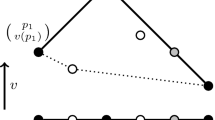Abstract
Mixed multi-unit combinatorial auctions are auctions that allow participants to bid for bundles of goods to buy, for bundles of goods to sell, and for transformations of goods. The intuitive meaning of a bid for a transformation is that the bidder is offering to produce a set of output goods after having received a set of input goods. To solve such an auction the auctioneer has to choose a set of bids to accept and decide on a sequence in which to implement the associated transformations. Mixed auctions can potentially be employed for the automated assembly of supply chains of agents. However, mixed auctions can be effectively applied only if we can also ensure their computational feasibility without jeopardising optimality. To this end, we propose a graphical formalism, based on Petri nets, that facilitates the compact represention of both the search space and the solutions associated with the winner determination problem for mixed auctions. This approach allows us to dramatically reduce the number of decision variables required for solving a broad class of mixed auction winner determination problems. An additional major benefit of our graphical formalism is that it provides new ways to formally analyse the structural and behavioural properties of mixed auctions.
Similar content being viewed by others
References
Cramton, P., Shoham, Y., & Steinberg, R. (Eds.). (2006). Combinatorial auctions. MIT Press.
Walsh, W. E., Wellman, M. P., & Ygge, F. (2000). Combinatorial auctions for supply chain formation. In EC’00: Proceedings of the 2nd ACM conference on electronic commerce (pp. 260–269). New York, NY: ACM.
Walsh W., Wellman M. (2003) Decentralized supply chain formation: A market protocol and competitive equilibrium analysis. Journal of Artificial Intelligence Research 19: 513–567
Cerquides, J., Endriss, U., Giovannucci, A., & Rodriguez-Aguilar, J. A. (2007). Bidding langua- ges and winner determination for mixed multi-unit combinatorial auctions. In Proceedings of the 20th international joint conferences on artificial intelligence (IJCAI) (pp. 1221–1226). Hyderabad, India.
Vinyals M., Giovannucci A., Cerquides J., Meseguer P., Rodriguez-Aguilar J.A. (2008) A test suite for the evaluation of mixed multi-unit combinatorial auctions. Journal of Algorithms 63(1–3): 130–150
Giovannucci, A., Rodriguez-Aguilar, J. A., Cerquides, J., & Endriss, U. (2007). Winner determination for mixed multi-unit combinatorial auctions via petri nets. In AAMAS’07: Proceedings of the 6th international joint conference on autonomous agents and multiagent systems (pp. 710–717). New York, NY: ACM.
Murata, T., (1989). Petri nets: Properties, analysis and applications. In Proceedings of the IEEE (Vol. 77, pp. 541–580).
Sandholm, T., Suri, S., Gilpin, A., & Levine, D. (2002). Winner determination in combinatorial auction generalizations. In AAMAS’02: Proceedings of the first international joint conference on autonomous agents and multiagent systems (pp. 69–76). Bologna: ACM Press.
Caplice, C., & Sheffi, Y. (2006). Combinatorial auctions for truckload transportation (Chap. 21). In Combinatorial auctions. MIT Press.
Cantillon, E., & Pesendorfer, M. (2006). Auctioning bus routes: The London experience (Chap. 22). In Combinatorial auctions. MIT Press.
Bichler, M., Davenport, A., Hohner, G., & Kalagnanam, J. (2006). Industrial procurement auctions (Chap. 23). In Combinatorial auctions. MIT Press.
Ball, M. O., Donohue, G. L., & Hoffman, K. (2006). Auctions for the safe, efficient, and equitable allocation of airspace system resources (Chap. 20). In Combinatorial auctions. MIT Press.
Pekec A., Rothkopf M.H. (2003) Combinatorial auction design. Management Science 49(11): 1485–1503
Krishna, V. (2002). Auction theory. Academic Press.
Milgrom, P. (2004). Putting auction theory to work. Cambridge University Press.
Nisan, N. (2006). Bidding languages for combinatorial auctions (Chap. 9). In Combinatorial auctions. MIT Press.
Rothkopf M.H., Pekec A., Harstad R.M. (1998) Computationally manageable combinational auctions. Management Science 44(8): 1131–1147
Andersson, A., Tenhunen, M., & Ygge, F. (2000). Integer programming for combinatorial auction winner determination, In Fourth international conference on multiagent systems (ICMAS 2000) (pp. 39–46). Boston, MA: IEE Press.
Sandholm T. (2002) Algorithm for optimal winner determination in combinatorial auctions. Artificial Intelligence 135(1–2): 1–54
Fujishima, Y., Leyton-Brown, K., & Shoham, Y. (1999). Taming the computational complexity of combinatorial auctions: Optimal and approximate approaches. In Proceeding of the sixteenth international joint conference on artificial intelligence (IJCAI’99) (pp. 548–553).
Leyton-Brown, K., Shoham, Y., & Tennenholtz, M. (2000). An algorithm for multi-unit combinatorial auctions. In Proceedings of the American association for artificial intelligence conference (AAAI) (pp. 56–61).
Lehmann, D., Müller, R., & Sandholm, T. (2006). The winner determination problem (Chap. 12). Combinatorial auctions. MIT Press.
Müller, R. (2006). Tractable cases of the winner determination problem (Chap. 13). Combinatorial auctions. MIT Press.
Sandholm, T. (2006). Optimal winner determination algorithms (Chap. 14). Combinatorial auctions. MIT Press.
Giovannucci, A. (2008). Computationally manageable combinatorial auctions for supply chain automation, Ph.D. thesis, Universitat Autonoma de Barcelona. Departamento de ciencias de la Computacion. http://specs.upf.edu/files/u20/Monografia.pdf
Petri, C. (1966). Kommunikation mit Automaten. Univ. Bonn, Institut für Instrumentelle Mathematik, Schriften des IIM Nr. 2, 1962, Technical report (English translation: RADC-TR-65-377, Griffiths Air Base), New York.
Lipton, R. (1976). The reachability problem requires exponential space. Technical Report 62, Yale University.
Tarek A., Lopez-Benitez N. (2004) Optimal legal firing sequence of Petri nets using linear programming. Optimization and Engineering 5(1): 25–43
Engel, Y., Wellman, M. P., & Lochner, K. M. (2006). Bid expressiveness and clearing algorithms in multiattribute double auctions. In EC’06: Proceedings of the 7th ACM conference on electronic commerce (pp. 110–119). New York, NY: ACM Press.
Esparza J., Melzer S. (2004) Verification of safety properties using integer programming: Beyond the state equation. Formal Methods in System Design 16: 159–189
Author information
Authors and Affiliations
Corresponding author
Rights and permissions
About this article
Cite this article
Giovannucci, A., Cerquides, J., Endriss, U. et al. A graphical formalism for mixed multi-unit combinatorial auctions. Auton Agent Multi-Agent Syst 20, 342–368 (2010). https://doi.org/10.1007/s10458-009-9085-x
Published:
Issue Date:
DOI: https://doi.org/10.1007/s10458-009-9085-x




